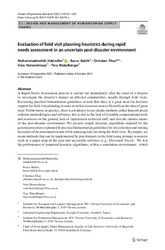Evaluation of field visit planning heuristics during rapid needs assessment in an uncertain post-disaster environment
| dc.contributor.author | Hakimifar, M. | |
| dc.contributor.author | Koyuncu, Burcu Balçık | |
| dc.contributor.author | Fikar, C. | |
| dc.contributor.author | Hemmelmayr, V. | |
| dc.contributor.author | Wakolbinger, T. | |
| dc.date.accessioned | 2023-04-04T10:44:51Z | |
| dc.date.available | 2023-04-04T10:44:51Z | |
| dc.date.issued | 2022-12 | |
| dc.identifier.issn | 0254-5330 | en_US |
| dc.identifier.uri | http://hdl.handle.net/10679/8104 | |
| dc.identifier.uri | https://link.springer.com/article/10.1007/s10479-021-04274-y | |
| dc.description.abstract | A Rapid Needs Assessment process is carried out immediately after the onset of a disaster to investigate the disaster’s impact on affected communities, usually through field visits. Reviewing practical humanitarian guidelines reveals that there is a great need for decision support for field visit planning in order to utilize resources more efficiently at the time of great need. Furthermore, in practice, there is a tendency to use simple methods, rather than advanced solution methodologies and software; this is due to the lack of available computational tools and resources on the ground, lack of experienced technical staff, and also the chaotic nature of the post-disaster environment. We present simple heuristic algorithms inspired by the general procedure explained in practical humanitarian guidelines for site selection and routing decisions of the assessment teams while planning and executing the field visits. By simple, we mean methods that can be implemented by practitioners in the field using primary resources such as a paper map of the area and accessible software (e.g., Microsoft Excel). We test the performance of proposed heuristic algorithms, within a simulation environment , which enables us to incorporate various uncertain aspects of the post-disaster environment in the field, ranging from travel time and community assessment time to accessibility of sites and availability of community groups. We assess the performance of proposed heuristics based on real-world data from the 2011 Van earthquake in Turkey. Our results show that selecting sites based on an approximate knowledge of community groups’ existence leads to significantly better results than selecting sites randomly. In addition, updating initial routes while receiving more information also positively affects the performance of the field visit plan and leads to higher coverage of community groups than an alternative strategy where inaccessible sites and unavailable community groups are simply skipped and the initial plan is followed. Uncertainties in travel time and community assessment time adversely affect the community group coverage. In general, the performance of more sophisticated methods requiring more information deteriorates more than the performance of simple methods when the level of uncertainty increases. | en_US |
| dc.language.iso | eng | en_US |
| dc.publisher | Springer | en_US |
| dc.relation.ispartof | Annals of Operations Research | |
| dc.rights | openAccess | |
| dc.rights.uri | https://creativecommons.org/licenses/by/4.0/ | |
| dc.title | Evaluation of field visit planning heuristics during rapid needs assessment in an uncertain post-disaster environment | en_US |
| dc.type | Article | en_US |
| dc.description.version | Publisher version | |
| dc.peerreviewed | yes | en_US |
| dc.publicationstatus | Published | en_US |
| dc.contributor.department | Özyeğin University | |
| dc.contributor.authorID | (ORCID 0000-0002-3575-1846 & YÖK ID 24250) Balçık, Burcu | |
| dc.contributor.ozuauthor | Koyuncu, Burcu Balçık | |
| dc.identifier.volume | 319 | en_US |
| dc.identifier.issue | 1 | en_US |
| dc.identifier.startpage | 517 | en_US |
| dc.identifier.endpage | 558 | en_US |
| dc.identifier.wos | WOS:000703357600001 | |
| dc.identifier.doi | 10.1007/s10479-021-04274-y | en_US |
| dc.subject.keywords | Disaster response | en_US |
| dc.subject.keywords | Heuristics | en_US |
| dc.subject.keywords | Rapid needs assessment | en_US |
| dc.subject.keywords | Selective routing | en_US |
| dc.subject.keywords | Simulation | en_US |
| dc.identifier.scopus | SCOPUS:2-s2.0-85116394054 | |
| dc.relation.publicationcategory | Article - International Refereed Journal - Institutional Academic Staff |
Files in this item
This item appears in the following Collection(s)
Share this page




